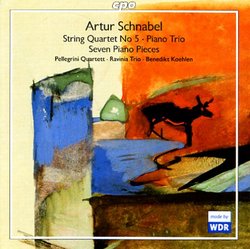| All Artists: Artur Schnabel, Ravinia Trio, Benedikt Koehlen Title: Artur Schnabel: String Quartet No. 5; Piano Trio; Seven Piano Pieces Members Wishing: 0 Total Copies: 0 Label: Cpo Records Release Date: 2/22/2005 Genre: Classical Styles: Chamber Music, Historical Periods, Classical (c.1770-1830) Number of Discs: 1 SwapaCD Credits: 1 UPC: 761203988129 |
Search - Artur Schnabel, Ravinia Trio, Benedikt Koehlen :: Artur Schnabel: String Quartet No. 5; Piano Trio; Seven Piano Pieces
 | Artur Schnabel, Ravinia Trio, Benedikt Koehlen Artur Schnabel: String Quartet No. 5; Piano Trio; Seven Piano Pieces Genre: Classical |
Larger Image |
CD Details |
CD ReviewsSchnabel's Music, 3 stars; Performances, 5 stars J Scott Morrison | Middlebury VT, USA | 07/16/2005 (4 out of 5 stars) ""You will never be a pianist; you are a musician," -- Theodor Leschetizky to Artur Schnabel
"Tell me, are you really the Schnabel who wrote that terrible piece I heard in Venice?" -- Arturo Toscanini to Artur Schnabel Known, of course, for his interpretation of the Beethoven and Schubert piano sonatas, as well as his peerless printed edition of the Beethoven scores, Schnabel was an indefatigable composer whose works never received much attention. Few of them were ever published. It was well-known, from the performances some of these works did have, that they were written in a knotty style similar to that of the members of the Second Viennese School--Schoenberg, Berg and Webern. His compositions include three symphonies, five string quartets, a piano concerto written when he was only nineteen, many songs and piano pieces, a piano trio, and his last composition, a duodecimet for strings, wind and percussion. Included here are his last quartet, Seven Piano Pieces and the Piano Trio. The Fifth Quartet, written in Colorado in 1940, was premièred by the Galimir Quartet in New York the next year, and it was broadcast (and recorded) by NBC. Another performance by the Juilliard Quartet was recorded in 1952. I have heard neither of those recordings. This recording by the Pellegrini Quartet, which specializes in contemporary music, was made in Cologne in 2002. From the sound of it they are a very fine group. It is my duty to report, though, that although one can admire the Schnabel quartet for its tight construction, it is a tough nut to crack. One can hear overwrought hyperchromaticism reminiscent of Berg, but without Berg's charm, as well as Webernian use of silence as a musical element. But until the dancelike fourth movement this quartet simply did not speak to me. The fourth movement, though, keeps one's interest primarily via its rhythmic drive. The Piano Trio (1945) seems to have tendency towards tonality, at least a times. The second movement, Larghetto, makes use of tight canonic writing of the Bergian sort. The third and last movement, Moderato ed energico, is the most interesting of the three. The piano trio texture makes it easier to follow the trio's musical argument and the performance by members of the Ravinia Trio, plus pianist Benedikt Koehlen, is terrific. The final work is 'Seven Piano Pieces' (1946/47) played by Koehlen. These are aphoristic miniatures -- seven pieces lasting a total of 13 minutes -- spare, astringent, often using silence as a building block. Slow and fast movements alternate with the slow movements getting slower and slower as the fast movements get faster and faster. The seventh piece is a sort of epilogue. I found more to enjoy in these pieces than in the earlier works and Koehlen's playing is a delight. Recorded sound is quite good. TT=62:17 Scott Morrison" |
